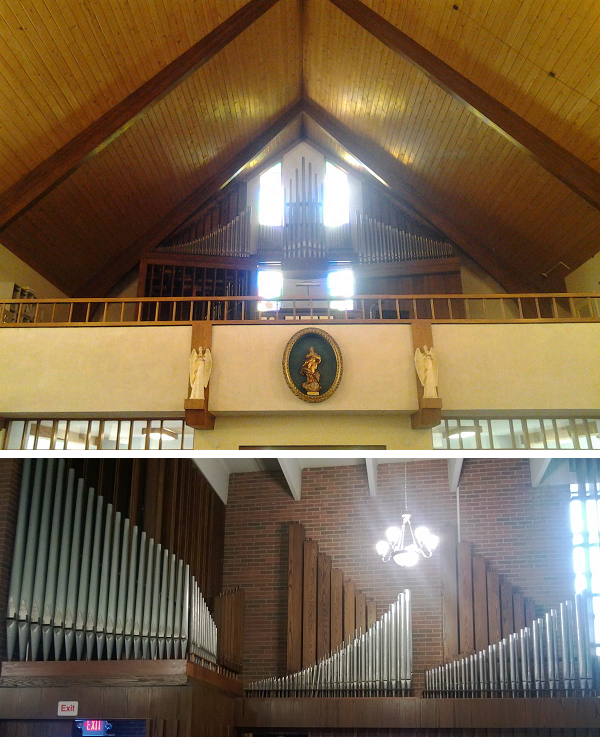St. Mary of the Assumption Catholic Church
Charlevoix, Michigan
Casavant Frêres, Opus 2947, 1967
Rebuilt and Enlarged as Opus 37R by Wigton Pipe Organs, Dryden, Michigan
Casavant Frêres, Opus 2947, 1967
Rebuilt and Enlarged as Opus 37R by Wigton Pipe Organs, Dryden, Michigan

In 1967 Casavant Frères of St. Hyacinthe, Quebec, built the
organ for Our Lady of Sorrows Church in Detroit. Some years after
the church was closed, the organ became available, and we
recommended it for installation at St. Mary's. It replaces a much
smaller unit organ installed in 1964. That instrument now serves
as a choir rehearsal organ at Assumption Grotto parish in Detroit.
This organ comes from a time in which the neo-classic ideal was
being reborn. Organs from the period are characterized by low wind
pressures, smaller scales, and rich harmonic development. There
also tends to be more speech transient noise, which needs to be
adjusted for the acoustics of the room. In making plans for moving
the organ, we recommended a couple of modest additions. The
original 8' Spitz Principal was available only in the Pedal. This
is such a basic stop for the chorus that we felt it was important
to make it available in the Great division, so new pipes were added
to complete that rank. We also added a Céleste to the Swell.
This stop is purposely mis-tuned slightly sharp to give it a
shimmering sound for quiet effects.
As can be seen in the photo, one big challenge was to adjust the
layout of the organ to fit the new room. The original
configuration was totally asymmetrical, since the organ was in a
corner of the room. To allow for a symmetrical arrangement around
the window, we installed the Swell division under the Great. We
built new casework for the other side, which houses the blower and
the static reservoir. The Pedal chest above it was reversed, as was
one of the chests for the large wooden Subbass pipes. We installed
the Spitz Principal in the center, building new windchests and
reservoir for that stop. We installed a multiplex control system,
which includes a multi-level combination action, and has provisions
for a transposer and record/playback features.
Pipe organ projects are very labor-intensive; we spent almost 1600
hours on this project. Several people were involved over the course
of the work: Edwin Judd, dismantling; Michael O'Neill and Lee
Western, electrical wiring, assembly and installation; Richard
Swanson, voicing and tonal finishing; David Wigton, dismantling,
voicing, installation, tuning.
STOPLIST Great 8' Spitz Principal 61 pipes Zinc, spotted metal, 29 new pipes 8' Rohrflute 61 pipes Zinc, spotted metal 4' Principal 61 pipes Spotted metal 2' Blockflute 61 pipes Spotted metal 1-1/3' Mixture III 183 pipes Spotted metal Swell 8' Gemshorn 61 pipes Zinc, spotted metal 8' Gemshorn Céleste 54 pipes Casavant (Starts at GG) 8' Gedeckt 61 pipes Zinc, spotted metal 4' Gemshorn 61 pipes Casavant 4' Spitzflute 61 pipes Spotted metal 2' Principal 61 pipes Spotted metal 8' Oboe 61 pipes Zinc, spotted metal Tremulant Pedal 32' Resultant Acoustic 16' SubBass 32 pipes Stopped wood 8' Spitzprincipal (From Great) 8' Bourdon 12 pipes Stopped wood 4' Choral Bass 32 pipes Spotted metal Console Couplers - G/P8, S/P8, S/P4, S/S16, S/S4, S/G8, S/G4 Tilting tablet console Compass: 61/32 Combination Action: Six General thumb pistons, toe studs for Great to Pedal and Full Organ Transposer and Player pistons Balanced shoe for Swell expression Totals 13 stops, 15 ranks, 857 pipes

